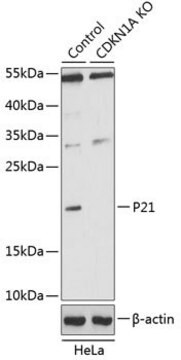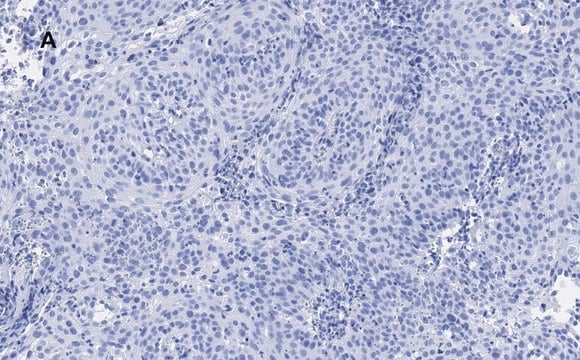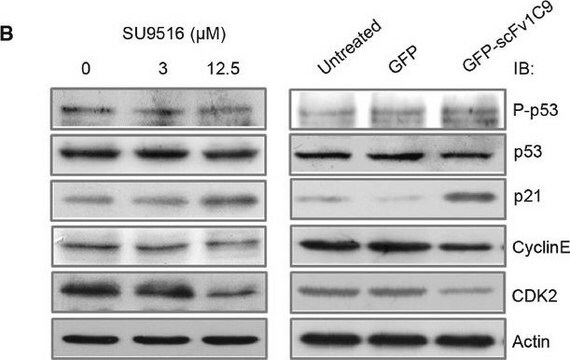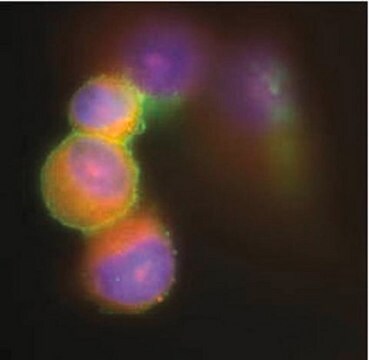OP64
Anti-p21WAF1 (Ab-1) Mouse mAb (EA10)
liquid, clone EA10, Calbiochem®
Synonym(s):
Anti-CIP1, Anti-SD11, Anti-p21, Anti-WAF
Sign Into View Organizational & Contract Pricing
Select a Size
All Photos(1)
Select a Size
Change View
About This Item
UNSPSC Code:
12352203
NACRES:
NA.43
Recommended Products
biological source
mouse
Quality Level
antibody form
purified antibody
antibody product type
primary antibodies
clone
EA10, monoclonal
form
liquid
contains
≤0.1% sodium azide as preservative
species reactivity
human
should not react with
mouse, rat
manufacturer/tradename
Calbiochem®
General description
Recognizes the ~21 kDa p21WAF1 protein in skin and colon tissue and in cells expressing wild-type p53 (e.g. Hs27 or U205 cells treated with DNA damaging agents).
This Anti-p21WAF1 (Ab-1) Mouse mAb (EA10) is validated for use in FC, Immunoblotting, IF, IP, Paraffin Sections for the detection of p21WAF1 (Ab-1).
Application
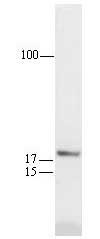
Flow Cytometry (2 g/ml or use Cat. No. OP64F; see application references)
Frozen Sections (5 g/ml or use Cat. No. OP64F)
Immunoblotting (1-3 g/ml)
Immunofluorescence (1-5 g/ml or use Cat. No. OP64F)
Immunoprecipitation (2 g/sample)
Paraffin Sections (5 g/ml or use OP64F; heat pre-treatment required; see comments and application references)
Packaging
Please refer to vial label for lot-specific concentration.
Warning
Toxicity: Standard Handling (A)
Analysis Note
Positive Control
Any cell line expressing wild-type p53 (e.g. Hs27 or U2OS treated with DNA-damaging agents) or skin or colon tissue
Any cell line expressing wild-type p53 (e.g. Hs27 or U2OS treated with DNA-damaging agents) or skin or colon tissue
Other Notes
Agarwal, M.L., et al. 1995. Proc. Natl. Acad. Sci. USA92, 8493.
Chen, Y.Q., et al. 1995. Int. J. Oncology7, 889.
Deng, C., et al. 1995. Cell82, 675.
El-Deiry, W.S., et al. 1995. Cancer Res.55, 2910.
Waldman, T., et al. 1995. Cancer Res.55, 5187.
Elbendary, A., et al.1994. Cell Growth Diff.5, 1301.
El-Deiry, W.S., et al. 1994 Cancer Res.54, 1169.
Li, R., et al. 1994. Nature371, 534.
Michieli, P., et al. 1994. Cancer Res.54, 3391.
Noda, A., et al.1994. Exp. Cell Res.211, 90.
El-Deiry, W.S., et al.1993. Cell75, 817.
Gu, Y., et al. 1993. Nature366, 707.
Harper, J.W., et al.1993. Cell75, 805.
Xiong, Y., et al.1993. Genes Devel.7, 1572.
Xiong, Y., et al.1993. Nature366, 701.
Xiong, Y., et al.1992. Cell71, 505.
Chen, Y.Q., et al. 1995. Int. J. Oncology7, 889.
Deng, C., et al. 1995. Cell82, 675.
El-Deiry, W.S., et al. 1995. Cancer Res.55, 2910.
Waldman, T., et al. 1995. Cancer Res.55, 5187.
Elbendary, A., et al.1994. Cell Growth Diff.5, 1301.
El-Deiry, W.S., et al. 1994 Cancer Res.54, 1169.
Li, R., et al. 1994. Nature371, 534.
Michieli, P., et al. 1994. Cancer Res.54, 3391.
Noda, A., et al.1994. Exp. Cell Res.211, 90.
El-Deiry, W.S., et al.1993. Cell75, 817.
Gu, Y., et al. 1993. Nature366, 707.
Harper, J.W., et al.1993. Cell75, 805.
Xiong, Y., et al.1993. Genes Devel.7, 1572.
Xiong, Y., et al.1993. Nature366, 701.
Xiong, Y., et al.1992. Cell71, 505.
Maximal p21WAF1 expression requires wild type p53 activity. Treatment of U2OS or MCF7 cells with DNA damaging agents (such as doxorubicin at 0.2 µg/ml) induces wild type p53 expression which in turn activates WAF1 expression. Serum stimulation of quiescent cells will give low level WAF1 expression independent of p53 expression. Untreated cells will express little p21WAF1 and can be used as a negative control. Cat. No. OP64F was tested in HALT cells induced by incubation at 31°C; FITC-goat anti-mouse IgG (Cat. No. DC13L) was used as a negative control. This antibody will immunoprecipitate p21WAF1 but not associated proteins. For immunoblotting applications, use a 0.22 µm filter and visualize by chemiluminescence. For staining paraffin sections, heating the tissue in 10 mM citrate buffer is required (see application references). In either paraffin or frozen sections of normal human colon, the non-dividing cells of colonic epithelium will stain positive for p21WAF1 while the proliferating compartment of crypts will not stain. Antibody should be titrated for optimal results in individual systems.
Legal Information
CALBIOCHEM is a registered trademark of Merck KGaA, Darmstadt, Germany
Not finding the right product?
Try our Product Selector Tool.
Storage Class
11 - Combustible Solids
wgk_germany
WGK 1
flash_point_f
Not applicable
flash_point_c
Not applicable
Certificates of Analysis (COA)
Search for Certificates of Analysis (COA) by entering the products Lot/Batch Number. Lot and Batch Numbers can be found on a product’s label following the words ‘Lot’ or ‘Batch’.
Already Own This Product?
Find documentation for the products that you have recently purchased in the Document Library.
Mingxuan Xia et al.
Cell cycle (Georgetown, Tex.), 7(11), 1604-1612 (2008-06-04)
The p53 tumor suppressor is a powerful growth suppressive and pro-apoptotic molecule frequently inactivated in human cancer. Many tumors overproduce its negative regulator MDM2, a specific p53 ubiquitin ligase and transcriptional inhibitor, to disable p53 function. Therefore, p53 activation by
Vladimir A Shamanin et al.
Molecular and cellular biology, 24(5), 2144-2152 (2004-02-18)
Inactivation of the ARF-p53 tumor suppressor pathway leads to immortalization of murine fibroblasts. The role of this pathway in immortalization of human epithelial cells is not clear. We analyzed the functionality of the p14(ARF)-p53 pathway in human mammary epithelial cells
I Osen et al.
British journal of urology, 81(6), 862-869 (1998-07-17)
To determine the prognostic role of p53, Ki-67 and p21 for patients with muscle-invasive bladder cancer treated with curative intent by radiotherapy. The study included 131 patients (24 women and 107 men, median age 72 years, range 40-86) with transitional
J L Nargi et al.
Neoplasia (New York, N.Y.), 1(6), 544-556 (2000-08-10)
Epidemiological evidence has suggested an association between diets rich in antioxidants and diminished risks of various types of cancer. Proposed mechanisms for protective effects of antioxidants have involved inhibition of free radical-mediated DNA damage. Recent data suggest that antioxidants may
Karin Hoppe-Seyler et al.
International journal of molecular medicine, 23(3), 415-420 (2009-02-13)
The malononitrilamide FK778 is a novel immunosuppressive agent with antiproliferative activities. To gain insight into the molecular mechanism of FK778-mediated growth inhibition, we analyzed cells which differ in their p53 status and functionality of retinoblastoma protein (pRb). FK778 acted as
Our team of scientists has experience in all areas of research including Life Science, Material Science, Chemical Synthesis, Chromatography, Analytical and many others.
Contact Technical Service